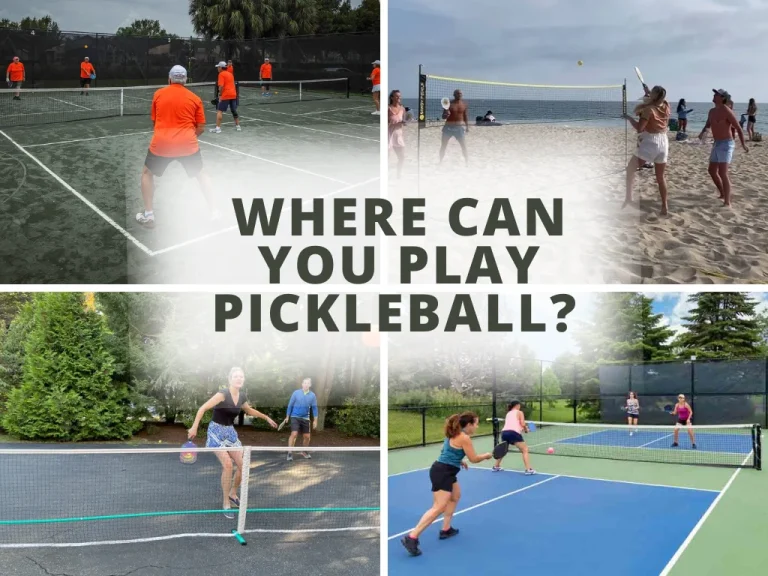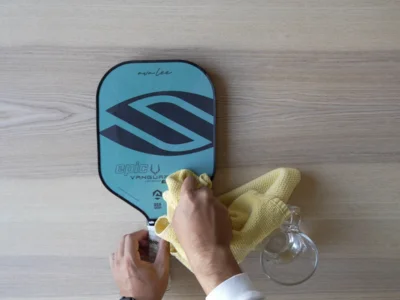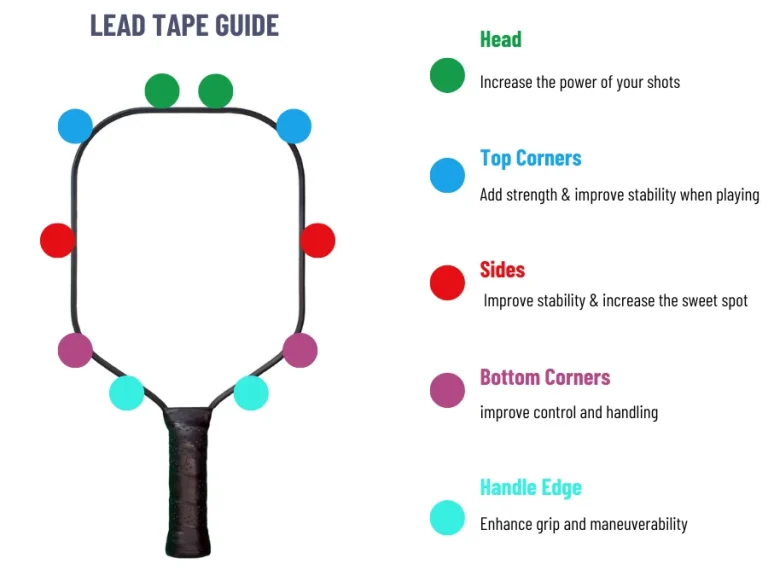Are you new to pickleball and wondering about the difference between indoor and outdoor play? You’re not alone! Many beginners assume that pickleball is pickleball, regardless of where it’s played.
However, crucial distinctions between indoor vs outdoor pickleball can significantly impact your game. Therefore, this article was born to delve into key differences, such as equipment, noise, popularity, etc. After reading carefully, you can expect to distinguish between these 2 sports!
We are sure that there’s a secret about what makes indoor vs outdoor pickleballs differ will be revealed! By the end of this article, you will also have a clear understanding of what happens if you use indoor pickleballs outdoors and vice versa. Which one is better?

After countless matches on my climate-controlled court, I ventured out for some outdoor play. At first, everything appeared familiar. There are not too many differences in my feelings when playing, but I realized something was different.
This revelation sparked a thought: Even if a player like me also meets the confusion, the newbie will be! This thought motivated me to write this information to share my experience!
Overview Table
| Feature | Indoor Pickleball | Outdoor Pickleball |
|---|---|---|
| Ball | – Fewer, larger holes (26) for slower speed and more control – Softer plastic for easier handling – Lighter weight (0.78-0.80 oz) – More texture for spin | – More, smaller holes (40) for faster speed and wind resistance – Harder plastic for durability – Slightly heavier weight (0.80-0.935 oz) – Less texture |
| Durability | More durable due to softer plastic and controlled environment | Less durable due to harder plastic and exposure to elements |
| Paddle | Lighter weight for maneuverability and control | Midweight or heavyweight for power and durability |
| Shoes | Focus on grip and agility for smooth surfaces | Focus on durability and shock absorption for rough surfaces |
| Noise | Quieter due to softer balls and enclosed environment | Louder due to harder balls and open environment |
| Difficulty | Easier due to controlled environment | More challenging due to weather and environmental factors |
| Eyeglass | Not Required | Recommended for improved visibility and eye protection |
Are Indoor Vs Outdoor Pickleballs The Same?
Pickleballs are available in two main types: indoor and outdoor. And they are not the same 100%.
Based on researching and hands-on experience in both indoor and outdoor pickleball reveal several key differences. The most notable distinctions are in the ball characteristics, including the number of holes, hole diameter, weight, and durability. These variations significantly impact how the ball behaves during play. Additionally, other equipment such as paddles and shoes are tailored differently for indoor and outdoor use.
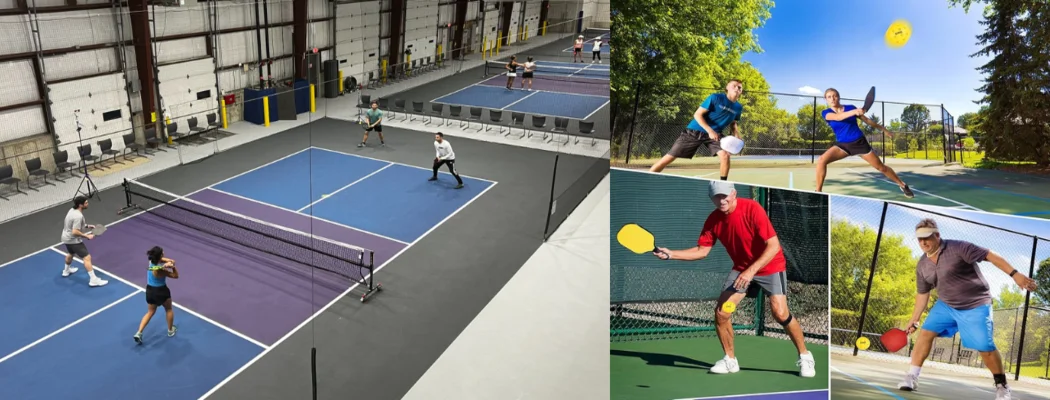
Explain in a simple way to understand:
The first difference everyone can see is that indoor pickleball will be played indoors, and outdoor pickleball will be played outdoors!
Indoor pickleballs typically have 26 larger holes. In contrast, outdoor pickleballs usually have 40 smaller holes. This difference is because the size and number of holes can affect how the ball moves in the air.
Outdoor balls have more, smaller holes to help them resist wind. On the other hand, indoor balls have fewer, larger holes because wind is not a concern indoors.
Additionally, the choice of the ball can be influenced by the climate and the court surface. The right ball can provide the appropriate weight, hardness, texture, and durability for the playing conditions.
Regardless of the ball’s characteristics, this article also analyzes the effect of external factors on shoes, tape, paddles, etc, in both 2 sports.
Key Differences
In this part, we not only provide you with the key differences from reputable statistics and sources! But we also explain why the differences exist!
1. Equipment
1.1 Ball
– Number of Holes:
The number of holes in a pickleball is designed to maintain the consistency and flight trajectory of your shots. The difference in the number of holes between indoor vs outdoor pickleballs is primarily due to the different conditions they are designed for.
- Indoor Pickleballs: 26 holes, which are larger in size.
- Outdoor Pickleballs: 40 holes, which are smaller in size.
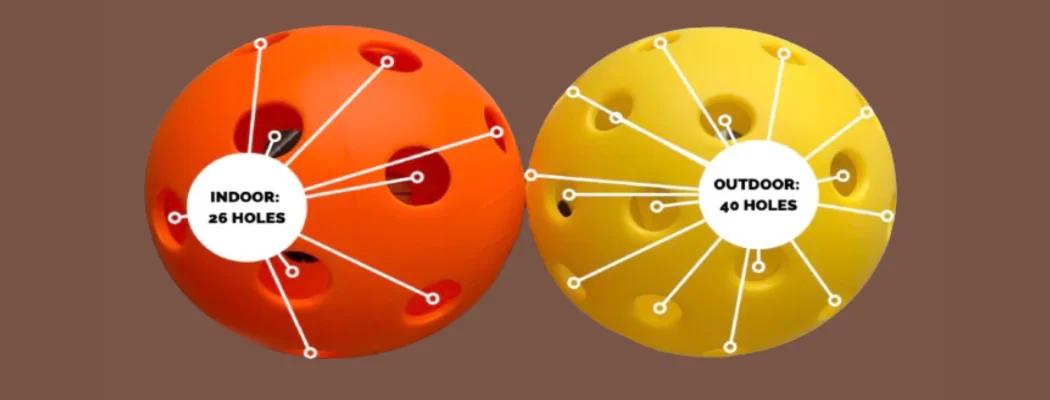
Indoor pickleballs typically have 26 larger holes. The fewer holes allow the ball to move slower and have less air resistance, making them easier to control. This is particularly beneficial in an indoor environment where wind and other weather conditions do not affect the game. The larger holes also contribute to the ball’s softer feel, which can lead to longer rallies.
In contrast, outdoor pickleball usually has 40 smaller holes. The increased number of holes offers more robustness for playing in windy conditions. The smaller holes create more air resistance, causing the ball to move faster and making it harder to control. This design helps the ball stay true to each shot and neutralize as many external factors as possible, such as wind.
– Hole Diameter:
Indoor pickleballs are designed with larger holes compared to outdoor pickleballs! The reason is primarily due to the different playing conditions they are meant for.
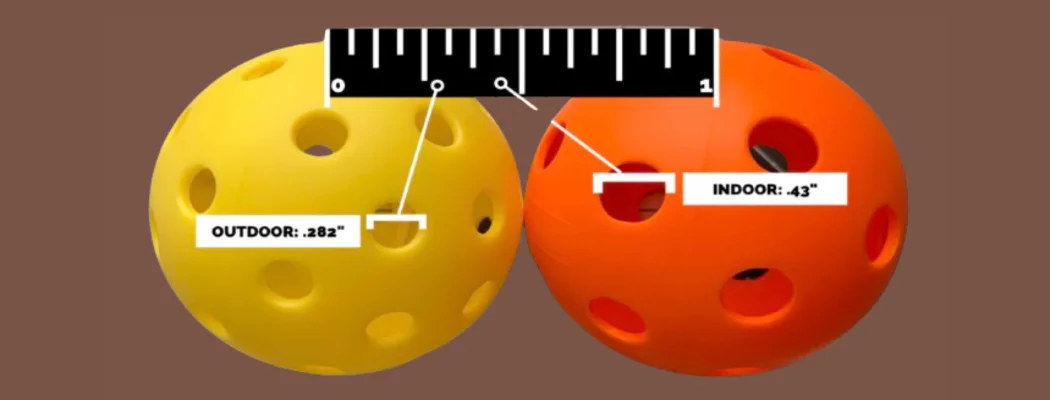
Explanation from a science perspective
Larger holes in indoor ballscreate more air resistance. More air resistance will slow down the ball’s speed. This slower pace is ideal for indoor play since it gives players more control over the ball! Therefore, it is easier to place shots where they want them.
Additionally, indoor balls are usually made from softer plastic, which, combined with the larger holes, contributes to easier ball control.
This design is not 100% good! The softer material and larger holes create more drag, making fast shots more challenging. But on the flip side, this increased drag means the ball doesn’t bounce as much, often leading to longer rallies.
Lastly, indoor pickleball models usually have more textures than outdoor models, and the larger holes can better grip the paddle surface, allowing for more spin on the ball.
So, in essence, the larger holes in indoor pickleball contribute to a slower, more controlled game! It is ideal for indoor play conditions.
Vice versa, smaller holes in the ball are also suitable for outdoor pickleball conditions!
– Weight:
Outdoor balls are heavier than indoor balls! As stated by reputation reports:
- An indoor pickleball typically weighs around 0.78 to 0.80 ounces (22 to 22.7 grams).
- An outdoor pickleball generally weighs slightly more, around 0.80 to 0.935 ounces (22.7 to 26.5 grams).
The reason outdoor balls are heavier than indoor balls is primarily due to the different materials used.
Outdoor balls are made of harder and thicker plastic, which makes them less affected by wind and allows them to come off the paddle faster and harder. The extra weight also helps to resist wind interference, providing more consistent play.
This contrasts with indoor balls, which are lighter and designed for slower play in a controlled environment.
In summary, the differences in weight between indoor and outdoor pickleballs are designed to optimize performance based on the specific playing conditions.
– Durability:
Indoor pickleballs are better than outdoor pickballs in durability.
As mentioned, indoor pickleball balls are generally made from softer plastic. This softer material is more resilient and less prone to cracking, splitting, and deformities. Plus, the indoor environment also has smooth surfaces and controlled conditions! All the things are less harsh on the balls. As a result, indoor pickleball balls can withstand more hits and maintain their shape and integrity for a more extended lifespan.
However, indoor balls tend to develop soft spots when they wear out. These soft spots can affect the ball’s bounce and flight, which can impact the quality of the game. It is a worthy experience!
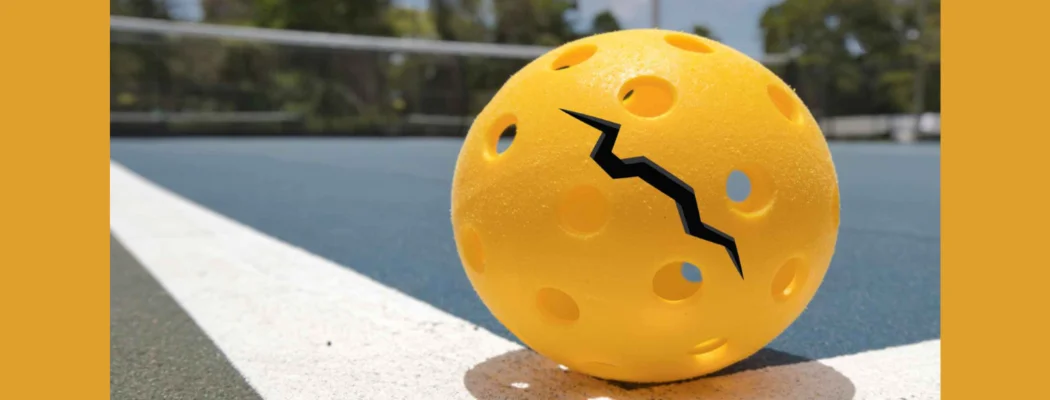
In contrast, outdoor pickleball balls are made from a harder plastic material! This material is specifically designed to withstand the rougher surfaces of outdoor courts. While this durability makes them more susceptible to cracking and splitting, it ensures a robust performance in challenging outdoor conditions.
Outdoor pickleball balls are exposed to the elements, including sunlight, heat, and moisture, all of which can wear down the balls more quickly. The rougher surfaces of outdoor courts can also cause more wear and tear on the balls. Therefore, it is not hard to understand that all these conditions lead to a shorter lifespan.
For more about pickleball ball, you can read at: How To Choose A Pickleball Ball: Color, Weight, Size & More
1.2. Paddle
Regarding paddle regulations from USAP, indoor and outdoor pickleball both use the same type of paddle. However, it’s important to consider that the ball’s bounce on an indoor court is smoother than on an outdoor court. Therefore, when playing pickleball indoors, it’s best to use a lighter and easier-to-handle paddle.
1.3. Shoes
Indoor pickleballshoes are designed for smooth, polished surfaces such as gym floors or indoor courts. These surfaces require shoes with non-marking soles to prevent scuffing and damage. The soles must also provide optimal grip to avoid slipping during fast-paced games.
This is why indoor pickleball shoes focus on grip and agility. Support for lateral movements and cushioning for joint impact reduction are necessary since pickleball involves a lot of side-to-side movements and jumping! And it can put stress on the joints.
Breathable materials are often incorporated into the design of indoor shoes to provide comfort during intense matches since indoor environments can get warm and cause feet to sweat.
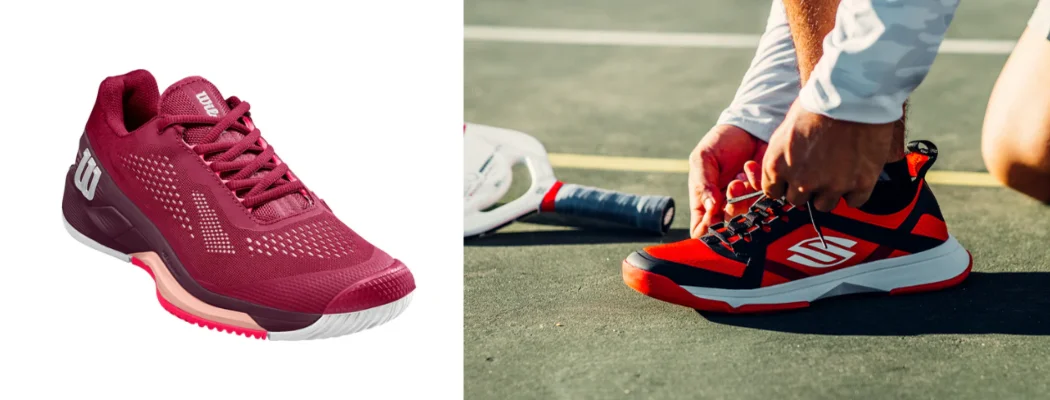
There are also some differences between outdoor pickleball shoes. They are built to withstand rougher court surfaces like concrete or asphalt. These surfaces can be hard on shoes, as a result of requiring them to be more durable.
This is why outdoor pickleball shoes prioritize durability and shock absorption. The soles of these shoes are made from high-quality rubber to withstand the rough terrain of outdoor courts and provide excellent grip.
Despite their rugged build, these shoes incorporate lightweight materials to ensure agility during play. The reason is pickleball involves a lot of quick movements, and heavy shoes can slow a player down.
1.4 Eyeglass
Just a friendly reminder for all my pickleball enthusiasts! Don’t forget to wear your eyeglasses or sunglasses when playing outdoors, especially in sunny places like Florida. Trust me, I’ve experienced the struggle myself.
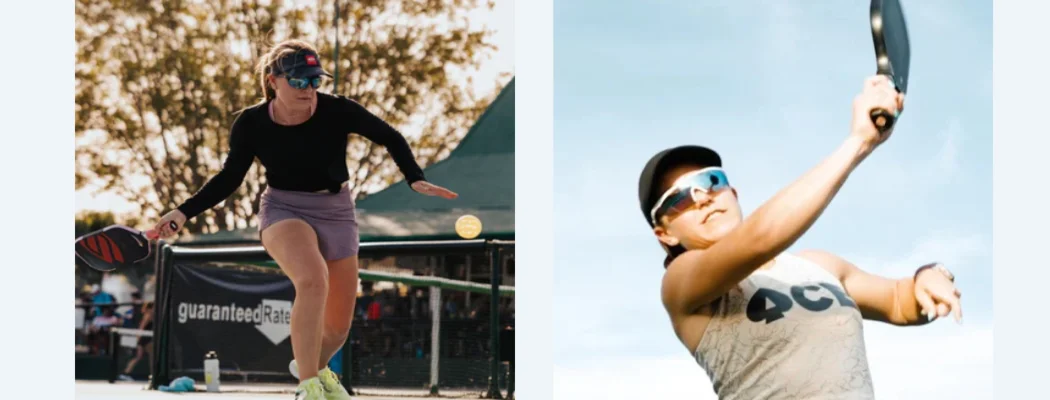
The bright sunlight and reflections off the court can make it super challenging to track the ball. It’s even tougher if you have sensitive eyes like I do. But it made a difference once I invested in a good pair of sports sunglasses.
Reduced glare, improved visibility, and protection from UV rays! Eyeglasses will support you in protecting your eyes! So, remember your eyewear next time you hit the outdoor courts. It’s a simple step that can really enhance your comfort and performance. Cheers to clear vision and great games!
2. Noise
The noise level in a pickleball game can vary based on whether it’s being played indoors or outdoors. Indoor pickleball tends to be quieter than outdoors! Let’s take a closer look at why noise differences exist.
- Indoor Pickleball: Indoor pickleball tends to be quieter due to softer balls and the controlled environment. The balls produce minimal noise upon impact! It makes them ideal for indoor play in noise-sensitive environments. However, one thing to know is that indoor courts are enclosed spaces, and the sound can create an echo.
- Outdoor Pickleball: The sound can be louder, especially when played with outdoor balls that produce a distinct “pop” sound when hit. While outdoor pickleball may generate slightly more noise, it offers excellent performance and durability for outdoor play. Outdoor courts are out in the open and are not enclosed by walls and ceilings! It can affect the noise level.
3. Difficulty
In my opinion, outdoor pickleballs will have a little difficulty compared to indoor pickleball! One of the primary factors that can make outdoor pickleball more challenging is the unpredictability of the weather and environmental conditions.
For instance, wind can significantly affect the game by altering the trajectory and speed of the ball! Therefore, players must constantly adjust their strategies. Similarly, changes in temperature and humidity can influence the ball’s bounce and the player’s physical comfort.
As you know, a ball for outdoor pickleball tends to bounce lower and move slower in colder temperatures. It may also bounce higher and move faster in warmer conditions.
Moreover, playing at different altitudes can also be problematic. The thinner air offers less resistance at higher altitudes, causing the ball to travel faster and farther.
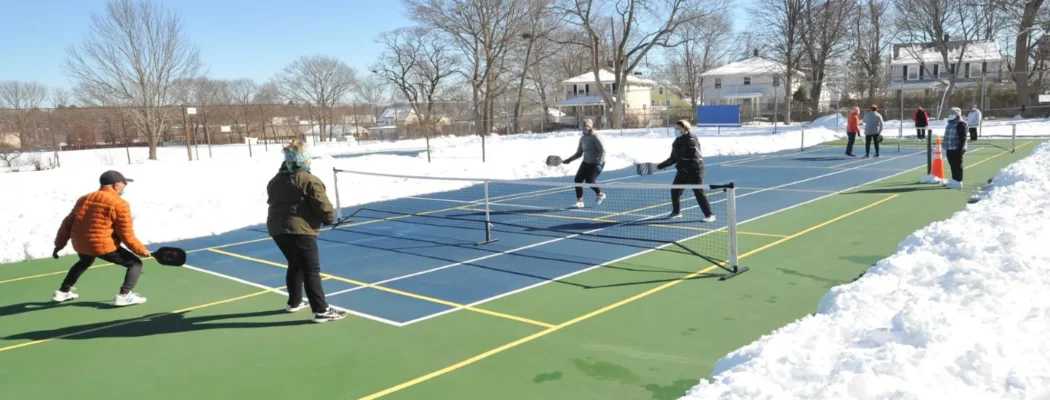
Sunlight and glare are other factors to consider. They can affect visibility, cause eye strain, and impact depth perception. Additionally, the sun’s position can influence heat and fatigue levels during the game.
4. Popularity
Several factors influence the popularity of indoor versus outdoor pickleball facilities. Geographical location, local climate, and preferences all influence where pickleball enthusiasts choose to play.
- Indoor facilities are more popular in urban areas with limited open space. The controlled environment of indoor facilities provides a consistent setting unaffected by the weather’s unpredictability. Additionally, indoor pickleball, with its larger holes and lighter weight, is well-suited for the smooth, often wooden surfaces of indoor courts, making it the ideal choice.
- Conversely, outdoor courts are favored in regions with milder climates and a strong outdoor sports culture. Public parks often feature outdoor pickleball courts, which are specifically designed for play in outdoor elements and on hard surfaces.
The Similarities
In summary, indoors and outdoors have similarities in the court and overview of the ball’s characteristics!
1. Court
1.1 Dimension
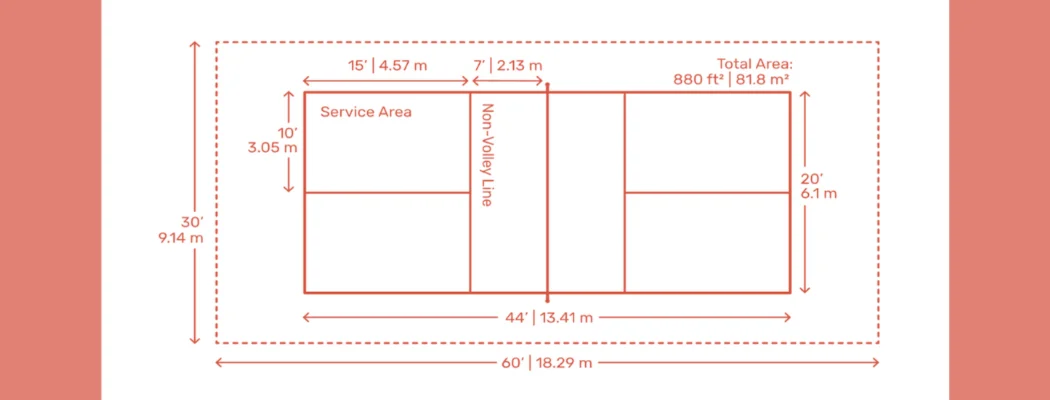
According to USPA, a standard pickleball court is 20 feet in width (6.1 meters) and 44 feet in length (13.41 meters). This measurement applies to both singles and doubles play.
A regulation pickleball court covers a total area of 880 square feet (81.7 square meters). Courts can be built indoors vs outdoors on a flat, smooth surface.
The court is divided into several sections: service areas and non-volley zones. Common surface materials include carpet, asphalt, concrete, or sports court tiles.
1.2 Net Height
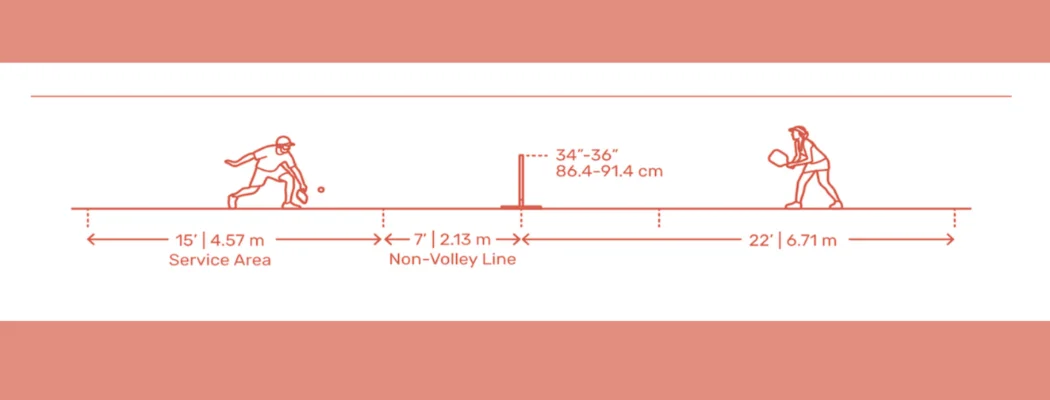
The net is set at 36 inches (0.914 m) at the sidelines & 34 inches (0.864 m) at the center. The regulation net width is 22 feet wide.
It extends one foot in each direction beyond the boundaries of the 20-foot court. To ensure visibility, the net’s top should be lined with a 2-inch white tape binding over a cord or cable.
1.3 Non-Volley Zone (Kitchen)
The non-volley zone (or kitchen) spans a 7-foot area on both sides of the net. Players are banded to volley the ball while standing in this zone! Doing so is considered a fault.
Additionally, maneuvering is prohibited! Some of these actions include standing within the non-volley zone, jumping up to hit a volley, and landing outside the non-volley zone.
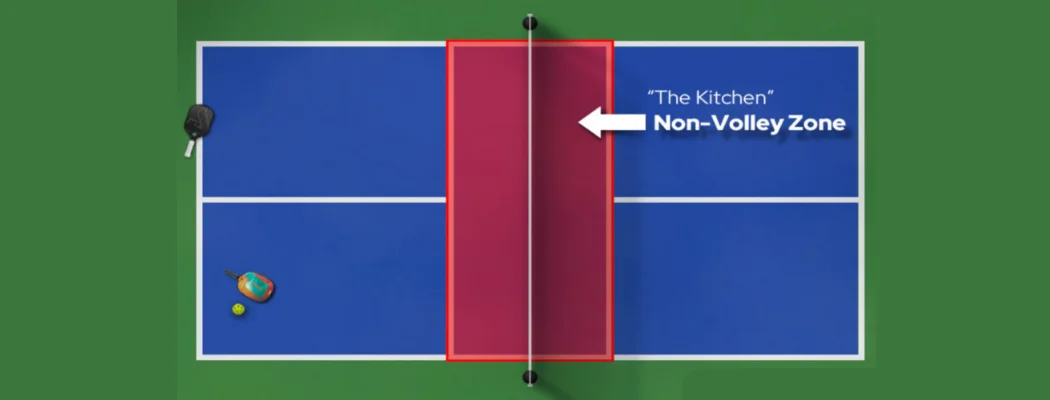
The uniformity of indoor and outdoor pickleball courts offers several advantages to players.
One key benefit is the transferability of skills! The identical court dimensions and rules mean that skills learned in one setting directly apply to the other. It allows players to practice and compete in varying conditions without adapting to different court sizes or rules.
Players can stick to their practice and play schedules regardless of the weather or season. You can seamlessly transition indoors without disrupting your training routine if outdoor conditions are unfavorable, such as during rain or snow.
Learning a sport with different rules and setups for indoor and outdoor play can also be intimidating, especially for beginners. So it’s easier for beginners to learn.
2. Game Rule
Pickleball can be played as doubles (two players per team) or singles! And doubles being the most common format.
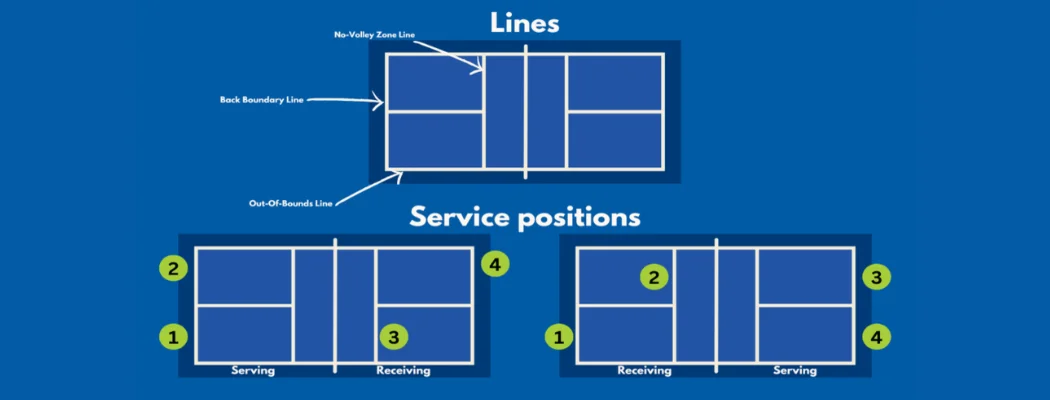
Points are scored only by the serving team.
Games are generally played by 11 points, winning by 2. Tournament games may be 15 or 21, win by 2.
- When the serving team’s score is even (0, 2, 4, 6, 8, 10), the player who was the first server in the game for that team will be in the right/even court.
- When odd (1, 3, 5, 7, 9), that player will be in the left/odd court.
Can I Use Indoor Pickleballs Equipment For Outdoors & Vice Versa?
1. Ball
Outdoor balls tend to be heavier and more rigid than indoor balls! Of course, this aids with more bounce. Because outdoor pickleballs are harder, they crack quicker than softer indoor pickleballs.
Thus, using an indoor ball outdoors might result in less control due to wind interference! The ball might wear out or crack faster due to the rougher outdoor surface.
Conversely, using an outdoor ball indoors might result in a higher bounce and faster speed! What a bad situation!
2. Paddle
When compare about pickleball paddles between indoor and outdoor, it actually does not have much of an impact whether you play indoors or outdoors!
When using lighter paddles outdoors, the wind factor is one of the main challenges. Due to their lightweight, wind can affect these paddles more. The wind can alter the trajectory of your shots! So you will find it harder to control the ball. Additionally, lighter paddles might provide less power for your shots!
On the other hand, using heavier paddles indoors is also not suitable if you are beginner. Heavier paddles can be harder to maneuver quickly, and the ball often moves faster and requires quick reactions. Using a heavier paddle can put more strain on your joints and muscles, potentially increasing the risk of injury.
3. Shoes
Indoor shoes have thinner walls for more air, better grip on smooth indoor surfaces, and support lateral movements. Outdoor shoes, on the other hand, are made from stronger materials for support and ventilation, have a more durable rubber sole, and offer better traction on rough outdoor surfaces.
Therefore, using indoor shoes outdoors might result in less grip and quicker wear and tear. Conversely, using outdoor shoes indoors might provide a different grip level and could mark or damage the indoor court surface.
Note tips
- Indoor Pickleball Shoes: Thinner walls for more air, Better grip on smooth surfaces, Support lateral movements, Lighter construction
- Outdoor Pickleball Shoes: Stronger materials for support, More durable rubber sole, Better traction on rough surfaces, Enhanced ventilation
Indoor Vs Outdoor Pickleballs: Which Is Better?
Indoor Better For…
Players who prefer indoor pickleball often value control and precision, as indoor balls are generally slower and offer better control.
These players might enjoy longer rallies and can adapt quickly to ball behaviors, such as skidding or skipping. Indoor courts can be pretty noisy, with sounds echoing off the walls, so players who aren’t easily distracted by noise might find indoor play more suitable.
Outdoor Better For…
Outdoor pickleball players who adapt well to weather conditions like wind and sun glare will feel good. The outdoor game is typically faster and more physically demanding, so players with good reflexes, agility, and stamina are appropriate.
The wind can add an extra layer of difficulty to outdoor play; players who enjoy challenges and can adapt to changing conditions are suitable!
In Short
This article addresses a common misconception among newcomers by showing the crucial differences between indoor vs outdoor pickleballs. As we’ve explored, while the core rules and court dimensions remain constant, the equipment, noise, difficulty, and popularity can vary significantly.
We hope that, after reading carefully, you will not be confused and assume indoor vs outdoor pickleballs are the same! This provided knowledge will help you choose the right equipment and adapt your technique accordingly.
You also choose which one is the most suitable for your personality and characteristics! Find more information for your pickleball paddle at Pickleball Blog. From expert experience and opinion, I hope that it will help you!

